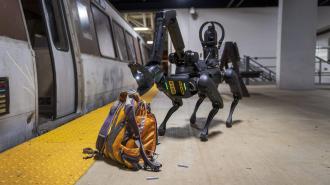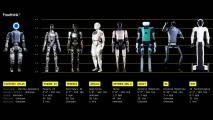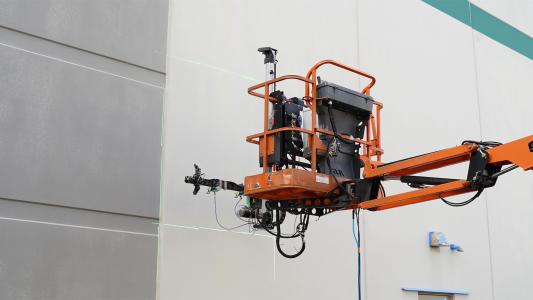The Los Angeles Police Department’s (LAPD) use of its new robot police dog to resolve a situation with an armed man illustrates how the machines can keep both officers and suspects out of harm’s way — but the potential for the tech to be used in more troubling ways in the future remains.
The case: On November 8, a passenger on a Los Angeles Metro bus told the driver that one of their fellow riders was sleeping with a gun below his seat, according to a report by KTLA News. The driver pulled the bus over, and everyone but the sleeping man evacuated.
The robot dog’s cameras allowed the officers to see the interior of the bus.
When members of the LAPD arrived on the scene just prior to 4 am, they tried to communicate with the armed man, but received no response.
They then called in a SWAT team, who sent a remote-controlled robot police dog onto the bus. The bot’s cameras allowed the officers to see the interior of the bus, and using its speakers, they were able to awaken the passenger and convince him to surrender at about 6:40 am.
No one was harmed during the event, and police recovered a BB gun from under the man’s seat afterwards.
New addition: The robot police dog used during the bus standoff was one of Boston Dynamics’ popular Spot robots, which have been used to treat patients in hospitals, study radiation at Chernobyl, and might one day explore Mars for NASA scientists.
Spot has also been controversially deployed, then retired, then redeployed by the New York Police Department for use in certain high-risk situations, such as barricaded suspects and hostage standoffs.
In March, the Los Angeles Police Foundation, a nonprofit that raises money to support the LAPD, offered to donate a version of the robot dog valued at nearly $280,000 to the LAPD. In May, the LA City Council voted 8-4 to accept the donation.
The controversy: As was the case in New York, critics have voiced concerns that the LAPD may misuse the robot police dog as a surveillance tool primarily in low-income communities of color.
“This item is being painted as merely an acceptance of a donation, but it really represents an expansion of the current boundaries around policing and surveillance,” said Councilman Hugo Soto-Martínez, who voted against accepting the robot. “This is not the vision of the community that I believe Los Angeles should be.”
The LAPD said it would never arm the robot police dog or equip it with facial recognition software.
The LAPD, meanwhile, has said that it will not deploy the robot police dog during regular patrol duties or surveillance operations. Instead, it will focus on using the bot to keep officers safe in a “limited number of scenarios.”
These include “incidents involving active shooters, assessment of explosives, hostage situations, natural disasters, hazardous material assessments, search and rescue missions, and barricaded suspects,” according to an LAPD press release.
The LAPD also said it would never arm the robot dog or equip it with facial recognition software, which can be inaccurate and racially biased — at least six Americans have reported being falsely arrested due to police use of the tech, and all of them have been Black.
Mechanical K9s: Police have been using robots to disarm bombs, inspect suspicious packages, and negotiate with hostage takers for years, but those bots are typically wheeled or on tracks, which means they can generally only navigate flat surfaces.
Robot dogs like Spot, with four legs, are far more agile, which is useful in situations like the Metro bus standoff, where the bot needed to trot up some stairs.
“It really represents an expansion of the current boundaries around policing and surveillance.”
Hugo Soto-Martínez
They’re capable of much higher levels of autonomy, too, though, and while Boston Dynamics prohibits customers from weaponizing Spot, we’ve seen examples of other manufacturers arming their robot dogs.
The concern shared by many critics of robot police dogs is that today’s deployment of a remote-controlled Spot in specific situations is a step down a road towards armed robots equipped with facial recognition software, autonomously patrolling the streets of America.
The bottom line: The Metro bus standoff seems to be the exact type of scenario the LAPD says it wanted a robot police dog to help it handle — had the man in the bus been deranged and more heavily armed, there’s a chance an officer might have been hurt confronting him.
The goal, then, is to find ways to make sure this new, highly capable piece of equipment is only used as intended.
In an attempt to ensure that happens in LA, the city council is requiring the LAPD to submit quarterly reports on the bot’s use. It has also retained the ability to suspend or modify the program in the future.
It’s too soon to say whether this extra scrutiny will prevent robot police dogs from being misused, but for now, the department appears to be using its new tool as intended.
We’d love to hear from you! If you have a comment about this article or if you have a tip for a future Freethink story, please email us at [email protected].






